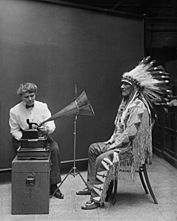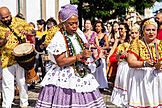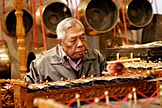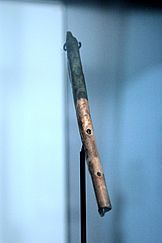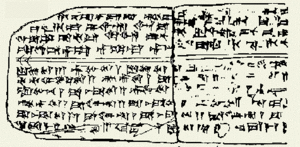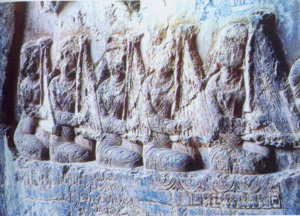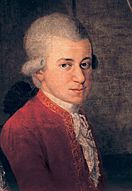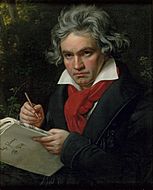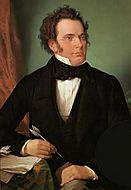History of music facts for kids
- The Seikilos column with the Seikilos epitaph, dated to the 2nd-Century CE or later
- Sculptures on the Jagdish Temple, Udaipur of musicians, one of which plays an instrument similar to the Rudra veena
- Mountain Chief recording on a phonograph for Frances Densmore, 1916
- Performers in the Samba de Roda festival, a music and dance celebration in the Bahia region of Brazil
- A man playing the gendèr outside of the Embassy of Indonesia, Canberra
- A man playing the didgeridoo, an indigenous instrument of Australia
- Joseph Haydn playing in a string quartet, in a painting from before 1790
Music is something found in every known culture around the world. It's considered a "cultural universal" because everyone, everywhere, makes and enjoys music, even though what counts as music can be very different from place to place.
The exact beginnings of music are still a big mystery. Many people think music and language might have started around the same time. Scholars from different fields have lots of ideas, but no single theory is widely accepted. Most cultures have their own special stories about how music began, often linked to their myths, religions, or beliefs.
The oldest clear evidence of music from prehistoric times dates back about 40,000 years ago, during the Upper Paleolithic period. This evidence comes from bone flutes. We don't know much about music from this very early time, but we have found simple flutes and percussion instruments. This shows that music was present in ancient societies like the Xia dynasty in China and the Indus Valley civilisation in India.
Once writing developed, music became part of ancient civilizations in places like China, Egypt, Greece, India, Persia, and the Middle East. It's hard to make general statements about all ancient music, but it often featured monophony (a single melody line) and improvisation (making it up as you go). In ancient songs, the words and music were very closely linked. While some old musical notes still exist, many ancient texts, like the Rigveda from India, survive without their music.
Over time, as trade routes like the Silk Road grew, different cultures started sharing musical ideas, practices, and instruments. For example, music in China's Tang dynasty was greatly influenced by traditions from Central Asia. In turn, Tang dynasty music influenced Japanese gagaku and Korean court music.
Historically, religions have often played a huge role in developing music. The Vedas of Hinduism deeply shaped Indian classical music, and the Five Classics of Confucianism formed the basis for later Chinese music. After Islam spread quickly in the 6th century, Islamic music became very important in Persia and the Arab world. The Islamic Golden Age even saw many important music thinkers.
Music written for and by the early Christian Church started the Western classical music tradition. In medieval music, new things like polyphony (multiple independent melodies), staff notation (writing music down), and early forms of many modern instruments began to appear. Besides religion, a society's music is shaped by everything else in its culture, including how people live, their economy, climate, and available technology. Many cultures combine music with other art forms, like the Chinese four arts (music, chess, calligraphy, painting). The feelings music expresses, where and when it's played, and how people view musicians and composers all change depending on the region and time period. Many cultures also separate music into different types, like art music (or 'classical music'), folk music, and popular music.
Contents
How Music Began
Music is found in every culture, but what it means can be different depending on the culture and time. It's still a big question how music first started, and scholars have many different ideas. The start of music is often talked about alongside the start of language. People wonder if music came before, after, or at the same time as language. For a long time, academics didn't pay much attention to these questions. But since the late 1900s, the topic has become very popular again.
Some main ideas about how music began include:
- Music as a way to attract mates: Charles Darwin suggested that music might have started as a way for humans to attract partners, similar to how some animals use mating calls.
- Music and language from a shared beginning: Some thinkers believe music and language both came from an even older form of communication.
- Music for practical reasons:
- To help people work together, like when groups need to coordinate their efforts.
- To make long-distance communication easier.
- To connect with gods or spirits.
- To help families and communities stick together and cooperate.
- To scare away dangerous animals or enemies.
- Music from two separate origins: One idea is that music started in two ways: one for communicating ideas (like speech) and another for expressing feelings.
Many cultures have their own special stories about how music was created. For example, in Christian stories, Jubal is said to have invented music. In Persian myths, the legendary king Jamshid is credited. The goddess Saraswati in Hinduism and the muses in Ancient Greek mythology are also linked to music's origins. Ancient Egyptian mythology connects music to several gods. In Chinese mythology, the musician Ling Lun is famous for inventing the bamboo flute by listening to mythical birds.
Music in Ancient Times
The earliest music we know about is called prehistoric music. This includes all music made by cultures before writing was invented. Music first appeared in the Paleolithic period. Most of the oldest instruments found are from Europe and date to the Upper Paleolithic. It's very possible that singing started much earlier, but it's impossible to prove.
The oldest possible instrument is the Divje Babe Flute from Slovenia, which is between 43,000 and 82,000 years old. It was made from a young cave bear bone. Scientists debate if it's truly a musical instrument or if animals just chewed on the bone. If it is a flute, it would be the oldest known musical instrument.
The earliest objects that are definitely musical instruments are bone flutes found in Germany. These flutes are from the Upper Paleolithic period and were used by early modern humans. There are eight examples, some made from bird bones and some from mammoth ivory. The oldest of these are about 43,000 years old.
Since these flutes are quite complex, it's likely that even simpler instruments existed before them. These might have been made from materials that don't last, like reeds, gourds, animal skins, or bark. Things like rattles, shakers, and drums were probably used by early hunter-gatherer societies. A painting in a cave in France, from about 15,000 BCE, seems to show a shaman playing a musical bow.
Prehistoric cultures probably used music for many different things. Music might have been especially important when food and other basic needs were hard to find. It's also likely that early humans felt music was deeply connected to nature and believed it could even influence the natural world.
In ancient China, the earliest instruments found are 12 gudi bone flutes from about 6000 BCE. These flutes were made from the bones of red-crowned cranes and are some of the oldest playable instruments in the world. In the Indus Valley civilisation (around 2500–2000 BCE), archaeologists found simple rattles and vessel flutes. Pictures from this time also suggest that early harps and drums were used.
Music in Ancient Civilizations
After writing was invented, ancient civilizations began to record their music. The first written music comes from Sumeria (modern-day Iraq) around 2600 BCE. The music of ancient societies was very diverse, but some common ideas appeared in almost all of them. These included monophony (single melody), improvisation, and the idea that words were the most important part of a song.
Ancient cultures in China, Egypt, Greece, India, Mesopotamia, and the Middle East all had different song forms. Music was often closely linked with magic, science, and religion. As ancient societies grew, more complex song forms developed, especially for big festivals in China, Greece, and India. The Silk Road also helped musical ideas and instruments spread between cultures. For example, a tuning key for a Chinese qin-zither from the 4th–5th centuries BCE has Persian designs on it.
Few actual examples of ancient music notation (written music) have survived. Most of what we know about ancient music comes from literature, pictures, and the instruments themselves. The oldest surviving written music is the Hurrian songs from Syria, with the oldest being a hymn from about 1400 BCE. However, the Seikilos epitaph is the earliest completely preserved musical composition. It's an epitaph (a message on a tombstone) from the 2nd century CE or later.
Ancient China
Shang and Zhou Dynasties
By the mid-13th century BCE, the late Shang dynasty (1600–1046 BCE) had developed writing. We know about their music from inscriptions on bones and bronze. Stone bells called qing were very popular with the Shang ruling class. While no flutes from the Shang dynasty have survived, writings suggest they used ocarinas (xun), transverse flutes (xiao and dizi), double pipes, and mouth organs (sheng).
With the arrival of bronze in 2000 BCE, the Shang dynasty used it to make bells. Drums, which appeared during the Shang period, were often made of wood. During the Zhou dynasty (1046–256 BCE), wind instruments were common, and the first Chinese string instruments appeared: the qin (or guqin) and se zithers.
A famous tomb from the Zhou dynasty, the Tomb of Marquis Yi of Zeng (after 433 BCE), contains many complex and decorated instruments. The most famous is a huge set of 65 tuned bianzhong bells. These bells cover five octaves and needed at least five players. They can still be played today and have rare inscriptions about music.
Ancient Chinese instruments were used for both practical and ceremonial purposes. People used them to ask for help from spirits for survival. Pan flutes might have been used to attract birds for hunting, and drums were common in sacrifices and military ceremonies. Chinese music has always been closely connected with dance, literature, and fine arts. Many early Chinese thinkers also believed music was important for good morals and governing society.
Music was a symbol of power for the Imperial court during the Shang and Zhou dynasties. It was used in religious services and to honor ancestors and heroes. Confucius (around 551–479 BCE) formally called music used for rituals and good morals yayue ("proper music"). He saw it as superior to suyue ("popular music"), which included almost all non-ceremonial music.
Confucius and his followers believed that leaders who preferred suyue over yayue lacked virtue. They thought music was deeply connected to the universe. For example, the 12-pitch shí-èr-lǜ system in Chinese music matched certain weights and measurements. The pentatonic scale (five notes) was linked to the five elements of Chinese philosophy.
Qin and Han Dynasties
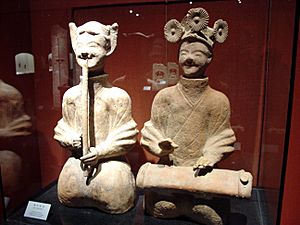
The Qin dynasty (221–206 BCE) was very short, but a supposed "burning of books" led to a big loss of earlier musical writings. During the Qin dynasty, the guzheng became very popular. This zither was more portable and louder, fitting the needs of a growing popular music scene.
During the Han dynasty (202 BCE – 220 CE), people tried to bring back the music of the Shang and Zhou, which was seen as "perfect." A Music Bureau, called the Yuefu, was set up around 120 BCE under Emperor Wu of Han. This bureau collected folk songs. This helped the Imperial Court understand what ordinary people were thinking, and it also allowed the court to change songs for propaganda and political reasons.
The Music Bureau had musicians for ceremonies, entertainment, and military events. They also wrote new music and set music to poems. The Han dynasty officially adopted Confucianism. However, many officials preferred more lively and informal music over Confucius's strict yayue. By 7 BCE, the Bureau had 829 musicians. That year, Emperor Ai of Han either closed or downsized the department due to money problems and the Bureau's focus on suyue, which went against Confucian ideas.
The Han dynasty also saw many musical influences from the Middle East and Central Asia. The Silk Road led to the exchange of instruments and new musical styles. Instruments like metal trumpets and instruments similar to the modern oboe and oud lute (which became the pipa) arrived. Other existing instruments became much more popular, especially the qin-zither (or guqin), which was seen as the most respected instrument, linked to good character.
Ancient Greece
Greek written history goes back a long way into Ancient Greece, and music was a big part of ancient Greek theatre. In ancient Greece, mixed-gender choruses performed for fun, celebrations, and religious reasons. Important instruments included the double-reed aulos (a wind instrument) and the plucked string instrument, the lyre, especially a special kind called a kithara.
Ancient India
The main sources of information about the music of ancient India are texts and pictures. Some theoretical writings in Sanskrit have survived, and there are brief mentions in general literature. Many sculptures of ancient Indian musicians and their instruments also exist. Ancient writings in Sanskrit, Pali, and Prakrit often mention music.
Despite this, we know little about the actual musical practices of ancient India. The information we have tends to give a similar view of music from that time, even though evidence suggests it was much more diverse. The important arts book Natya Shastra is one of the earliest and main sources for ancient Indian music. The parts about music are likely from the Gupta period (4th to 6th century CE).
Ancient Persia and Mesopotamia
Early Periods to Achaemenid Empire

It's hard to fully describe the earliest music in Persia because so few records have survived. Pictures from the Elam civilization (around 3300–3100 BCE) show arched harps, which are the first clear sign of Persian music. Elamite bull lyres from about 2450 BCE have been found. More than 40 small trumpets have been found in Central Asia, dating to around 2200–1750 BCE. These trumpets seem to have been linked to religion and animals.
In many ways, the earliest known musical cultures of Iran are strongly connected to those of Mesopotamia. Ancient arched harps (around 3000 BCE) also existed in Mesopotamia. Many more bull lyres have been found in Ur of Mesopotamia, like the famous Bull Headed Lyre of Ur. Pictures from the 2nd century BCE show that arched harps were replaced by angular harps. Lutes were supposedly used in Mesopotamia by at least 2300 BCE, but they only appear in Iran around 1300 BCE.
Rock carvings show that complex Persian court music groups appeared in the 1st century BCE, with the arched harp as the main instrument. The importance of musicians in these carvings suggests they were vital in religious ceremonies.
We know very little about the music of the Achaemenid Empire (550–330 BCE) from that time. Most of our knowledge comes from Greek historians. Herodotus noted that Achaemenid priests did not use aulos music in their ceremonies. Xenophon mentioned many female singers at court. Later Persian texts say that gōsān (poet-musicians) were important and highly respected in court.
Parthian and Sasanian Periods
The Parthian Empire (247 BCE to 224 CE) saw more texts and pictures showing musical activities and instruments. Drinking horns from the 2nd century BCE found in Nisa show vivid pictures of musicians. Pictures from Babylon show panpipes, string instruments (harps, lutes, and lyres), and percussion instruments (like tambourines). Bronze statues show larger panpipes and double aulos.
Music was clearly used in ceremonies and celebrations. A stone carving from the Parthian era shows a wedding with musicians playing trumpets, tambourines, and various flutes. Other evidence shows that gōsān minstrels continued to be important. Greek writers are still a major source of information. Strabo wrote that gōsān learned songs telling tales of gods and noblemen. Plutarch recorded that large drums were used by the Parthian army to prepare for war.
The Sasanian period (226–651 CE) has left much more evidence of music. This suggests a very active musical culture, especially in areas where Zoroastrianism was strong. Many Sasanian kings were big supporters of music, including Ardashir I and Bahram V. Khosrow II (who ruled from 590 to 628) was the most outstanding patron, and his reign is seen as a golden age of Persian music. Famous musicians who worked for Khosrow include Barbad, who was the most well-known. These musicians were usually minstrels, performing as both court poets and musicians. In the Sasanian Empire, there was little difference between poetry and music.
Other Ancient African Cultures
The Western African Nok culture (in modern-day Nigeria) existed from about 500–200 BCE and left many sculptures. Some of these show music, like a man shaking two objects thought to be maracas. Another sculpture shows a man with his mouth open, possibly singing, and there's also a sculpture of a man playing a drum.
Music in the Middle Ages
Japanese Gagaku Music
The imperial court of Japan developed gagaku (meaning "elegant music"). This music came from the Gagakuryō imperial music academy, which was set up in 701 CE during the Asuka period. Although the word gagaku comes from the Chinese yayue music, gagaku includes many different types of music, styles, and instruments.
In its early history, the three main types of gagaku were wagaku (native Japanese music), sankangaku (music from the Three Kingdoms of Korea), and tōgaku (music from China's Tang dynasty). What's special about gagaku is that many musical scores from the 8th to 11th centuries still exist, which is rare for Asian music of this time.
A big change in gagaku happened in the 9th century, when tōgaku and komagaku music became distinct. Tōgaku was influenced by Chinese styles and was called "Music of the Left." Komagaku was called "Music of the Right" and included music influenced by Korea and Balhae. These styles influenced each other. The long Heian period (794–1185) saw the court greatly support gagaku music, which was played at many festivals and celebrations. Many new types of songs emerged then. Gagaku groups use a wide variety of instruments and are the largest musical groups in traditional Japanese music.
Medieval European Music
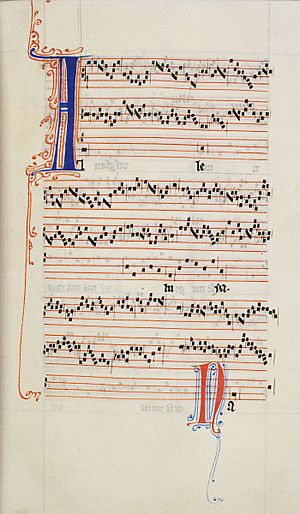
'Medieval music' generally refers to the music of Western Europe during the Middle Ages, from about the 6th to 15th centuries. Music was very important in the early Middle Ages, as shown by pictures of instruments and writings about music. However, the only music that has survived from before 800 CE is the plainsong church music of the Roman Catholic Church, mostly called Gregorian chant.
During the 9th century, several important things happened. First, the Church worked hard to make all chant traditions the same, favoring Gregorian chant. Second, the earliest polyphony (music with multiple singing parts) appeared, called organum. Third, and most importantly, music notation (writing music down) was reinvented after about 500 years. It took several more centuries for a system to develop that could precisely show pitch and rhythm, like modern music notation.
Several styles of polyphony grew after 1100. These included the St. Martial school and the Notre Dame school of polyphony, which had composers like Léonin and Pérotin. They created the first music for more than two parts around 1200. The Codex Calixtinus from Santiago de Compostela in Spain shows music where musicians from many traditions came together.
Besides church music, a lively tradition of secular (non-religious) songs developed. This included the music of the troubadours, trouvères, and Minnesänger. These were poets and musicians who traveled around. Much of the later secular music of the early Renaissance came from their ideas.
Forms of sacred music that developed in the late 13th century included the motet and conductus. The 14th century in European music is known for the ars nova style. Much of the music from this time is secular and uses specific song forms like the ballade and rondeau. Most pieces were for one to three voices, likely with instruments. Famous composers include Guillaume de Machaut and Francesco Landini.
Byzantine Music
Prominent and diverse musical practices were present in the Byzantine Empire, which existed from 395 to 1453. Both sacred (church) and secular (non-church) music were common. Sacred music was often used in church services, and secular music was played at many events, including ceremonies, dramas, ballets, banquets, festivals, and sports games. However, secular Byzantine music was strongly criticized by church leaders.
Composers of sacred music, especially hymns and chants, are generally well-known throughout Byzantine history. The first major form was the kontakion, with Romanos the Melodist as the most important composer. In the late 7th century, the kanōn became more popular. Andrew of Crete was its first significant composer. The kanōn reached its peak with the music of John of Damascus and Cosmas of Maiuma.
Composers of secular music are less known. Only late in the empire's history do we know composers by name, such as Joannes Koukouzeles. Like their Western counterparts, Byzantine composers were mainly men. Kassia is a major exception; she was an important composer of hymns and the only woman whose works became part of the Byzantine liturgy. A few other women are known to have been composers, but only one has any surviving work. Some Byzantine emperors were also composers, like Leo VI the Wise.
Music in Recent Centuries
Indian Classical Music
During ancient and medieval times, the classical music of the Indian subcontinent was largely unified. By the 14th century, political problems began to separate Northern and Southern India, and different traditions started to appear in each region. By the 16th century, two distinct styles had formed: Hindustani classical music in the North and Carnatic classical music in the South.
One of the main differences is that Northern Hindustani music was greatly influenced by Persian and Arab musical practices. Carnatic music is mostly devotional; most of its songs are addressed to Hindu gods. Indian classical music (marga) is monophonic, meaning it's based on a single melody line or raga that is organized rhythmically through talas.
Western Classical Music
Renaissance Music
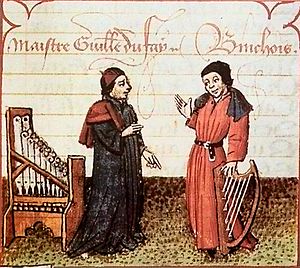
The start of the Renaissance in music is not as clear as in other arts. It didn't begin in Italy, but in northern Europe, in areas that are now central and northern France, the Netherlands, and Belgium. The style of the Burgundian composers, who were the first generation of the Franco-Flemish school, was a reaction against the overly complex music of the late 14th century. Their music had clear, singable melodies and balanced polyphony (multiple independent melodic lines). The most famous composers of the Burgundian school in the mid-15th century were Guillaume Dufay, Gilles Binchois, and Antoine Busnois.
By the mid-15th century, composers and singers from the Low Countries began to spread across Europe, especially into Italy. They worked for the pope and wealthy art patrons. They brought their smooth polyphony, which could be used for both sacred (church) and secular (non-church) music. Important sacred music forms at the time were the mass, the motet, and the laude. Secular forms included the chanson and later the madrigal.
The invention of printing had a huge impact on spreading musical styles. Along with the movement of Franco-Flemish musicians, it helped create the first truly international style in European music since Gregorian chant. Composers like Josquin des Prez became very famous. Music after Josquin became more complex in its counterpoint (how different melodies work together).

By the mid-16th century, the international style started to change. Several different styles appeared:
- A simpler style in sacred music, influenced by the Counter-Reformation, seen in the music of Giovanni Pierluigi da Palestrina.
- A more complex and colorful style in the madrigal, with composers like Carlo Gesualdo.
- The grand, rich music of the Venetian school, which used the architecture of San Marco di Venezia to create contrasting sounds. This school also developed orchestration (how instruments are used) and basso continuo (a continuous bass line), which were important for the next era. Famous composers in Venice included the Gabrielis and Claudio Monteverdi.
Most parts of Europe had active and unique musical traditions by the late 16th century. In England, composers like William Byrd wrote sacred music. Spain developed its own instrumental and vocal styles. Germany used polyphonic forms based on Protestant chorales. France developed a unique singing style called musique mesurée.
One of the most revolutionary movements happened in Florence in the 1570s and 1580s, with the Florentine Camerata. They wanted to bring back the music of the ancient Greeks. Their work led to a new singing style called monody and a staged dramatic form known today as opera. The first operas, written around 1600, mark the end of the Renaissance and the beginning of the Baroque era.
Before 1600, music was based on modes rather than tonality (major and minor keys). New ideas in the late 16th century led to the development of common practice tonality. Major and minor scales became more common. Music after 1600, starting with the Baroque era, is often called part of the common practice period.
Baroque Music
The Baroque era lasted from 1600 to 1750. During this time, music became much wider in its scope and more complex. Baroque music began when the first operas (dramatic solo singing with an orchestra) were written. In this era, polyphonic contrapuntal music, which uses multiple independent melody lines at the same time, remained important.
German, Italian, French, Dutch, Polish, Spanish, Portuguese, and English Baroque composers wrote for small ensembles including strings, brass, and woodwinds, as well as for choirs and keyboard instruments like the pipe organ, harpsichord, and clavichord. During this period, several major music forms were defined that lasted into later periods, including the fugue, the invention, the sonata, and the concerto. The late Baroque style was very complex with many layers of melody and rich decorations. Important composers from the Baroque era include Johann Sebastian Bach, George Frideric Handel, Claudio Monteverdi, and Antonio Vivaldi.
Classical Music
The music of the Classical period is known for its homophonic texture. This means there's a clear melody with an accompaniment. These new melodies were often very singable, almost like a voice. Because of this, instrumental music quickly became more popular than opera and other sung forms. However, opera didn't disappear. During the Classical period, some composers started creating operas for the general public in their own languages.
Along with the focus on clearer melodies, counterpoint (multiple melodies working together) became more of a decorative touch. Instead, simple patterns, like arpeggios (broken chords) and Alberti bass (a repeated pattern in the left hand of piano music), were used to add life to a piece without making it too complicated.
The popular instrumental music was dominated by several well-defined forms: the sonata, the symphony, and the concerto. All three come from sonata form, which is both the overall structure of a whole work and the structure of a single part of it. Sonata form became the main structure for instrumental pieces throughout the 19th century.
The early Classical period was led by the Mannheim School, which included composers like Johann Stamitz. This school greatly influenced Joseph Haydn and, through him, all later European music. Wolfgang Amadeus Mozart was the central figure of the Classical period. His amazing and varied works in all styles define how we see this period. Ludwig van Beethoven and Franz Schubert were composers who bridged the gap into the Romantic period, expanding existing music forms and ideas.
Romantic Music
In the Romantic period, music became more expressive and emotional. It started to connect with literature, art, and philosophy. Famous early Romantic composers include Schumann, Chopin, Mendelssohn, and Berlioz.
The late 19th century saw a huge increase in the size of the orchestra. Concerts also became a bigger part of city life. Famous composers from the second half of the century include Johann Strauss II, Brahms, Liszt, Tchaikovsky, Verdi, and Wagner.
Between 1890 and 1910, a third group of composers, including Grieg, Dvořák, Mahler, and Sibelius, built on the work of earlier Romantic composers. They created even more complex and often much longer musical works. A key feature of late 19th-century music is its strong national pride, shown by composers like Dvořák and Sibelius. Other important figures include Saint-Saëns, Fauré, and Rachmaninoff.
20th and 21st Century Music
The 20th century brought a revolution in how people listened to music. The radio became popular worldwide, and new technologies were developed to record, edit, and share music. Music performances became more visual with broadcasts and recordings.
20th-century music brought new freedom and wide experimentation. Composers tried new styles and forms that challenged the old rules of music. The invention of musical amplification and electronic instruments, especially the synthesizer, in the mid-20th century changed classical and popular music forever. This also sped up the development of new music forms.
In classical music, two main schools of thought shaped the century: that of Arnold Schoenberg and that of Igor Stravinsky. However, other composers also had a notable influence, such as Béla Bartók, Dmitri Shostakovich, and John Cage.
The 20th century saw the huge spread of popular music, which is music that appeals to many people. The term has its roots in the music of American Tin Pan Alley, a group of musicians and publishers who became important in New York City in the 1880s. While popular music is sometimes called "pop music," the terms are not always the same. Popular music refers to many music types that a large part of the population enjoys, while pop music usually refers to a specific type within popular music. Popular songs usually have easy-to-sing melodies. The structure of popular music often involves repeating sections, like the verse and chorus, with a bridge providing a contrasting part.
See also
 In Spanish: Historia de la música para niños
In Spanish: Historia de la música para niños




